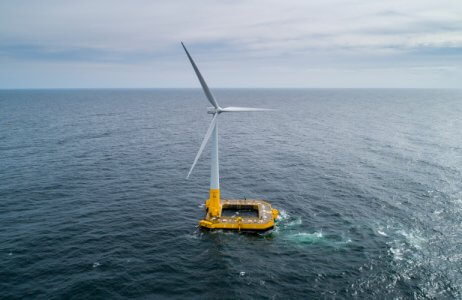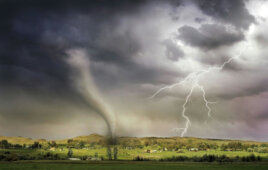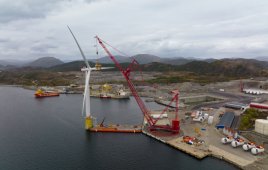By Mark Goalen, director of offshore engineering, Houlder
With offshore floating wind as a proven commercial reality, the challenges associated with the industry are now focused on delivering at scale, but there are still key innovation issues to be resolved across the industry.
Meeting targets
The global floating offshore wind industry is expected to reach 126 MW by the end of 2021 and to grow to 70 GW by 2040. As well as powering electricity grids around the world, floating wind will help decarbonize offshore oil and gas production and play a critical role in green hydrogen production.
Developers, insurers, financers and all stakeholders serious about making the significant advances needed to upscale floating offshore wind capacity to meet these expectations will be interested in reducing project risk, improving installation time and building robust supply chains that will function throughout their asset’s lifecycle.
Operational efficiency and technology options will continue to evolve over time. The challenge for developers is to remain open to innovation and look for continued improvement without impeding progress.
Foundation pros and cons
Choosing the best foundation technology is critical to delivering the best levelized cost of energy (LCOE) for floating offshore wind projects. The decision should be based on assessment of available port infrastructure and supply chains as much as water depth and environmental conditions.
As much as economies of scale based on consistency and repeatability are appealing, the choice of foundation type should not be made before site analysis. The physical attributes of foundations will influence where they can be fabricated and the ease with which they can be towed and moored, and detailed motion response should be compared on a case-by-case basis for any specific location. A foundation perfectly suited to the Mediterranean may not be viable in the Pacific.
There are currently four main types to choose from, with multiple options for each type and still several more innovative concepts under development. Firstly, spar buoys are cylindrical in shape and very stable given their deep draft with ballast creating a low center of gravity. They require a deep water area for fabrication and also for maintenance if towed to shore. They can be made from steel or concrete, and are conventionally catenary moored.
The other option is semi-submersible platforms which consist of typically three connected vertical columns. Considered suitable for most locations given that relatively shallow water required at fabrication site, stable for tow during installation and O&M, their biggest disadvantage is being prone to heave motion which is difficult to prevent without increased fabrication complexity. Semi-submersibles are generally fabricated from steel and conventionally catenary moored.
Tension leg platforms typically have a central column and arms connected to tensioned tendons. They can be assembled onshore or in a dry dock, but they can be harder to keep stable during transport and installation than other concepts. Their biggest advantage is that the taught mooring lines significantly reduce the length of mooring lines for deep water locations in comparison to a catenary moored structure.
Damping pool structures have a square barge structure which contains a damping pool that has been tuned to reduce the foundation motion. They can be made from concrete or steel — a factor that can increase flexibility of the fabrication location.
Project planning
Understanding the installation methodology and defining the developments and operations and maintenance strategy up front is also critical to determining which solutions are feasible and where the challenges lie. Initial findings from UK Offshore Renewable Energy Catapult (ORE) for a select set of scenarios suggest that it is cheaper to tow turbines to shore where crane operations are simpler and there is ready access to onshore services and personnel.
However, offshore wind developments can be remote from good port facilities, and there are risks associated with disconnecting and reconnecting the units and towing them to shore. As the Floating Wind Joint Industry Project recently concluded in its Phase III report, one of the main challenges for the tow-to-port option is the safe detachment and wet storage of cables and mooring connections. Conversely, for in-situ maintenance, there are challenges with the limitations of heavy lift vessels: many of the existing heavy lift vessels are unable to lift to the required hub height with the required reach for larger turbines.
Planning and logistics are clearly important and should be modelled in more depth than is possible in just a project schedule. A dynamic model that compares options and provides results based on what is important to the developer (cost, risk, carbon emission or schedule) would be a useful tool. The same model could include contingency factors such as installation weather limitations, unexpected schedule delays and their knock-on consequences. The output from the model will not only provide what is the best option for a site-specific development but will also establish the available budget to develop the O&M vessels that would be required to conduct repairs on location, and the bespoke tooling that will need to be designed to make that happen.
Dynamic development
Several types of floating foundations have now been proven in full-scale trials, and installation at commercial scale has been achieved, as evidenced by the completion of the world’s largest floating offshore wind farm to date, the 48-MW Kincardine Offshore Wind in Scotland.
Experience so far has demonstrated that some of the most developed technologies have encountered issues or have features that increase fabrication complexity. These will likely be phased out as the designs evolve, and it’s important that developers recognize this in their financial models. The floating industry can’t simply expect to capitalize on the experience of the much more mature fixed wind industry.
Foundation designs continue to evolve as new innovations resolve earlier technical difficulties, and new technologies continue to open up possibilities for reducing commercial and technical risk. The ORE Catapult report “Floating Offshore Wind: Cost Reduction Pathways to Subsidy Free” released this year notes that advances in fabrication, such as robotic welding complete with machine learning, will have a significant impact on project cost due to increased production efficiency.
A more integrated design interface between anchors, mooring system and substructure could speed up installation and major repair operations.
Additionally, autonomous robots could be employed to de-risk inspection and maintenance tasks. Indeed, last year, a six-legged robot successfully scaled a vertical blade on an offshore demonstration turbine.
Other exciting technology developments such as self-erecting nacelles and less conventional floating structure designs will continue to increase what is possible, while minimizing the cost of the vessels and tools required to handle the equipment.
The project developer’s “toolbox” continues to expand, but making the right decisions requires in-depth analysis of a multitude of influencing factors — a serious undertaking in terms of research but one that has the potential to pay dividends.
An industry-wide challenge
Development and design cycles naturally overlap. As warned in the ORE Catapult cost reduction report, turbine technology development could outpace the supporting technology required to install it. The need for new larger cranes and vessels could hinder project timelines, and ultimately the cost of fabricating and installing these larger components may outweigh the economic benefits of larger turbines.
Perhaps an even more fundamental, industry-wide issue than the already visible and articulated challenges is what remains unknown as a consequence of the risk profile of such complex projects. There are many interfaces and interactions required, that must work in harmony, not isolation, and some developers are opting for EPIC contracts to avoid fronting and managing the risks associated with multi-contract management. This is stifling opportunities for SME growth and development and therefore stifling innovation.
The EPIC approach reduces developers’ flexibility and potential to deliver cost reductions through innovative processes, new logistics chains, and dynamic contractual relationships. Restricting these opportunities to reduce costs and mitigate risks will hinder on-going decision making and could seriously slow growth potential across the industry.
Innovation is crucial
Innovation can take the industry from proven commercial-scale to full utility-scale developments capable of achieving the required LCOE at the volume of units required to hit or better the installed power targets. There is no shortage of companies prepared to invest in the development required. One barrier to this could be the investment required to develop the port infrastructure to fabricate the foundations is vast, and there needs to be confidence there will be sufficient volume of foundations to cover that investment. That approach lends itself to consistency and repeatability in fabrication which is difficult to achieve with so many drastically different options in existence and still under development. Regardless in every aspect of this embryonic industry, innovation will be crucial if offshore floating wind is to play a full part in future offshore energy provision.
 Mark Goalen is a MEng Naval Architect and Chartered Engineer with 17 years of experience in project engineering and management, subsea construction, vessel modification, consultancy work, design engineering and tendering. He commenced his career in a large multi-national installation contractor, prior to specializing in technical consultancy. He combines the wide-ranging experience to understand project risks, restraints and demands with use of technical knowledge to guide decision making. Today, Mark Goalen is director of offshore engineering for Houlder.
Mark Goalen is a MEng Naval Architect and Chartered Engineer with 17 years of experience in project engineering and management, subsea construction, vessel modification, consultancy work, design engineering and tendering. He commenced his career in a large multi-national installation contractor, prior to specializing in technical consultancy. He combines the wide-ranging experience to understand project risks, restraints and demands with use of technical knowledge to guide decision making. Today, Mark Goalen is director of offshore engineering for Houlder.
Filed Under: Featured






